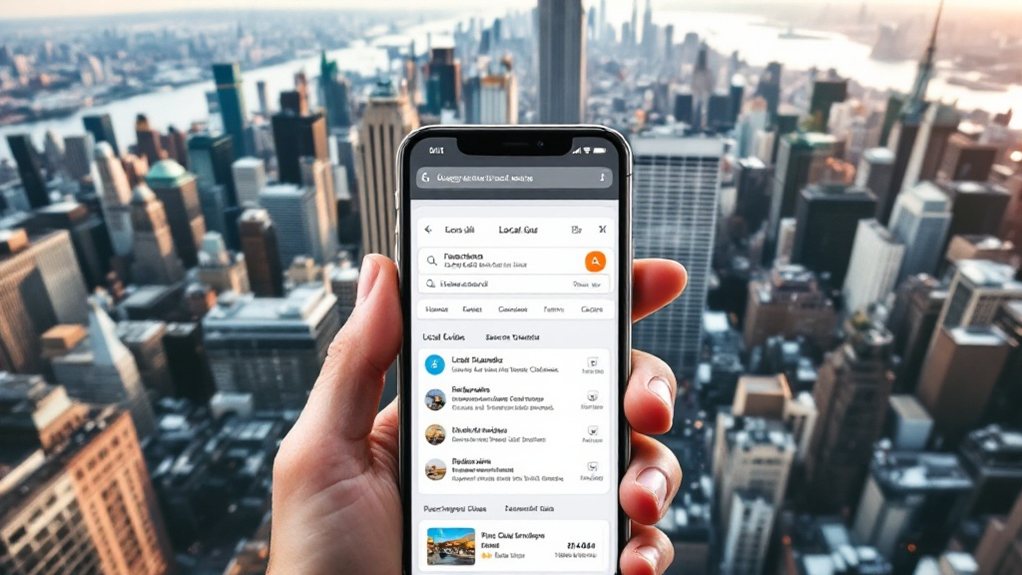To create local guides that rank well in search, you'll want to optimize for geographical relevance by incorporating location-specific keywords, leveraging geographic data, and ensuring consistent business information across platforms. Encourage customers to become local guides, claim and optimize listings, and create locally-relevant content. Enhance the user experience with intuitive navigation, captivating visuals, and continuous monitoring of performance metrics. By following these steps, you'll be well on your way to improving your local search visibility. To delve deeper, let's explore the key strategies in more detail.
Understanding Local User Intent

As a business owner, understanding local user intent is crucial for your search engine optimization (SEO) strategy. Local search queries often include keywords like "near me" or specific locations, indicating a desire for services, products, or places within a certain geographic area. The types of local search intent include transactional (making a purchase), navigational (seeking a specific business), and informational (looking for details). Local intent searches can be categorized as transactional, navigational, or informational. Mobile searches frequently emphasize local intent, and search engines personalize results based on user location and history. Optimizing for local intent can significantly increase your visibility and attract more local customers.
Optimizing for Geographical Relevance

Optimizing for geographical relevance is key to improving your local search visibility. Incorporate location-specific keywords in your content and metadata to boost rankings. Leveraging geographic data is crucial to understand local trends and create personalized content. Tailor your content to address the needs and preferences of specific geographic audiences. Ensure consistency of business information across online platforms and utilize Google My Business effectively. Optimize for mobile searches to enhance user engagement.
Leverage geotags to increase content relevance for local searches. Develop location pages with unique content to improve local visibility. Regularly produce content relevant to the local audience. Encourage customer reviews to improve online reputation and search rankings. Establish relationships with local businesses for strategic link building.
Leveraging Online Visibility Factors

Boosting your online visibility can be achieved by leveraging various factors. Encourage your customers to become Google Local Guides, who can increase user-generated content and help make your business more discoverable. Guides can create custom lists starting at level four, which must have a title and include a minimum of four places. Claim and optimize your listings on platforms like Yelp and Google My Business, ensuring consistency across all directories. Create local-centric content, focusing on relevant themes and incorporating specific keywords. Engage with your community by participating in local events and collaborating with other businesses. Regularly measure and analyze your visibility using analytics tools and SEO audits to identify areas for improvement.
Enhancing User Experience for Conversions
Enhancing the user experience is paramount for driving conversions on your local search guides. Intuitive navigation and simple menu structures facilitate quick access to key information, reducing bounce rates and boosting engagement. Tailored experiences underpinned by accurate personas can increase website traffic by up to 210%. Captivating, locally relevant content that's well-structured and easy to follow can increase user loyalty. High-quality visuals like images and videos enhance comprehension and enjoyment, while multimedia elements enrich the experience. Continuously monitor user feedback and performance metrics to identify areas for improvement, and involve user opinions to ensure your guides meet their expectations. Optimize for search engine visibility with targeted keywords and local SEO tactics to maximize the impact of your enhanced local guides.
Tracking and Analyzing Local Performance
Closely track your local performance metrics to monitor your progress. Leverage analytics tools to gain insights into your site traffic and user behavior. Optimize your local SEO strategy based on your proximity, prominence, and other key factors.
Monitor Local Performance
Regularly tracking and analyzing your local performance is crucial for staying ahead in the ever-evolving world of local search. Tools like Google Search Console, Google My Business Insights, and Local Rank Trackers provide valuable data on your search visibility, customer actions, and rankings. Monitoring key performance indicators (KPIs) such as local search rankings, Google My Business views, and organic traffic can inform your optimization efforts. Additionally, tracking your competitors' strategies, rankings, and content can help you capitalize on opportunities and adapt to market changes. By optimizing based on performance data, you can refine your keywords, improve local content, and enhance your local SEO authority.
| Key Local SEO Metrics | Importance |
|---|---|
| Local Search Rankings | Visibility in Local Pack and Google Maps |
| Google My Business Views | Search and map views |
| Customer Actions | Calls, website visits, and direction requests |
| Organic Traffic | Visitors from local organic searches |
| Referral Traffic | Traffic from local directories and citations |
Analyze Site Traffic Insights
Analyzing your site's traffic insights is crucial for understanding how local users engage with your content and optimizing your local search strategy. Track key engagement metrics like time on page, bounce rate, and pages per session for local visitors. Use tools like Google Analytics to understand the visitor flow and conversion rates. Ensure your site is mobile-friendly to enhance the user experience. Leverage user behavior tools like Hotjar to gain deeper insights. Monitor traffic from local searches, referrals, social media, and direct sources. Assess content performance, integrate geo-specific keywords, and regularly update your content. Utilize web analytics platforms, implement internal linking strategies, and track link performance to boost local SEO. [Identify opportunities to enhance the user experience based on traffic analysis data.
Optimize for Proximity, Prominence
To optimize for proximity, focus on creating location-specific content that caters to the needs of your local community. Develop guides that highlight your area's unique characteristics, and use geo-targeting strategies to make your pages more relevant to local searches. Embed Google Maps on relevant pages and provide area-specific FAQs to enhance visibility.
To optimize for prominence, build your business's reputation by encouraging customer reviews and earning backlinks from authoritative local sources. Produce high-quality, authoritative content to establish your expertise, and engage with the local community on social media. Participate in local events to increase your credibility and visibility.
Structuring Informative Local Content
When crafting informative local content, it's crucial to structure your guides in a way that engages readers and effectively conveys your message. Organize your information with a logical flow, using short paragraphs, clear subheadings, and strategic bullet points. Incorporate visual aids like images and statistics to support your text, and ensure you're using simple, accessible language. Ensuring your content is structured effectively can help your local guides rank better in search results.
| Organizing Principles | Best Practices |
|---|---|
| Logical Flow | Ensure each paragraph logically leads to the next |
| Short Paragraphs | Keep paragraphs concise (3-6 lines) for better readability |
| Subheadings | Use subheadings to structure and clarify main points |
| Bullet Points & Lists | Utilize bullet points and lists to present information effectively |
| Transitions | Use transitional phrases or sentences between sections |
Incorporating Localized SEO Techniques
Effectively incorporating localized SEO techniques is crucial for boosting your business's online visibility and reaching your target audience. Begin by optimizing your Google Business Profile, ensuring it's complete and showcases your unique offerings. Utilize relevant keywords throughout the profile to improve your search visibility. Leverage local citations to maintain consistent NAP (Name, Address, Phone) data across directories, improving your credibility. Encourage customers to leave reviews, and thoughtfully respond to both positive and negative feedback to enhance your online reputation. Finally, create location-specific content that caters to your community, leveraging long-tail and conversational keywords to improve your search rankings.
- Optimize Google Business Profile
- Maintain Consistent Local Citations
- Manage Online Reviews Effectively
- Produce Location-Specific Content
Utilizing Visual Elements for Engagement
Visual storytelling is a powerful way to connect with your local community and drive engagement. Incorporate authentic narratives, customer testimonials, and multimedia elements like photos, videos, and virtual tours to build brand loyalty. Optimizing your visual content and monitoring engagement metrics can further enhance your local visibility and customer experience.
Impactful Visuals for Engagement
How can you leverage impactful visuals to drive meaningful engagement with your local audience? Incorporate authentic visuals that highlight familiar landmarks and community events to foster a stronger connection. Encourage user-generated content like customer photos and testimonials to enhance authenticity and community engagement. Integrate local cultural elements into your visuals to add depth and relevance to your storytelling. Monitor visual content engagement and adjust based on audience feedback to maintain relevance.
- Authentic Visuals
- User-Generated Content
- Cultural Elements
- Visual Feedback
Embedding Multimedia Experiences
Embedding multimedia experiences into your local search guides can be a powerful way to further engage your audience. By incorporating videos, infographics, and interactive elements, you can make your content more visually appealing and memorable. When adding visuals, be sure to optimize them for search by including descriptive alt text and captions. Additionally, ensure the multimedia aligns with your overall content to maintain relevance. Platforms like Canva and Piktochart can help you create professional-looking graphics. Remember, high-quality visuals and a well-structured layout will improve the user experience and boost the effectiveness of your local search guides.
Fostering Community Involvement and Interactions
Effective community engagement begins with fostering strong relationships and empowering residents to participate in local initiatives. By leveraging collaborative and empowering strategies, you can build trust and encourage active involvement. Consider these tactics:
- Partner with community groups to tap into existing networks and boost participation.
- Highlight how initiatives impact local areas to increase community interest.
- Ensure diverse perspectives are included in decision-making processes.
- Organize volunteer events and educational workshops to mobilize and provide value to residents.
Complementing these efforts with online engagement platforms and strategic frameworks can further optimize your community outreach and foster meaningful interactions.
Measuring Success and Identifying Improvement Opportunities
Understanding local performance metrics is key to optimizing your search guides. Leverage analytics tools to track website traffic, engagement, and conversions inspired by your guides. Use these insights to refine your SEO tactics and content strategy for better visibility and impact.
Tracking Local Performance
Measuring the success of your local SEO efforts is crucial for understanding what's working and where you can improve. Leverage tools like Google Analytics, Google Search Console, and Google My Business Insights to track key metrics such as:
- Local pack rankings
- Organic rankings for local keywords
- Website traffic from local searches
- Actions taken on your Google Business Profile
- Conversion rates from local leads
Regularly monitoring these metrics and analyzing performance trends will help you identify opportunities for optimization, whether it's enhancing your online listings, improving content, or targeting underperforming locations. Stay agile and adjust your local SEO strategy based on the data insights.
Leveraging Analytics Insights
Leveraging the right analytics tools is key to gauging the success of your local SEO efforts and identifying opportunities for improvement. Google Analytics and Google Search Console provide invaluable insights into website performance, visitor behavior, and search visibility. Utilize tools like Local Falcon to track local SEO metrics, including Share of Local Voice scores. Monitor conversion rates and click-through-rates to measure the effectiveness of your local strategies. Analyze traffic sources, competitor data, and customer feedback to uncover areas for optimization. Regular reporting and content updates are essential to maintain relevance and competitiveness in local search.
Optimizing for SEO Metrics
Tracking the right SEO metrics is crucial for gauging the success of your local search strategies and identifying opportunities for improvement. Focus on metrics like organic traffic, click-through rate, bounce rate, and keyword rankings to assess the effectiveness of your optimizations. Additionally, monitor your local search rankings, customer reviews, and Google My Business metrics to refine your local SEO approach.
- Analyze low click-through rates to improve meta titles and descriptions.
- Investigate high bounce rates to optimize your content and user experience.
- Review keyword rankings periodically to identify gaps and refine your strategy.
- Encourage positive reviews to boost your local credibility and rankings.
